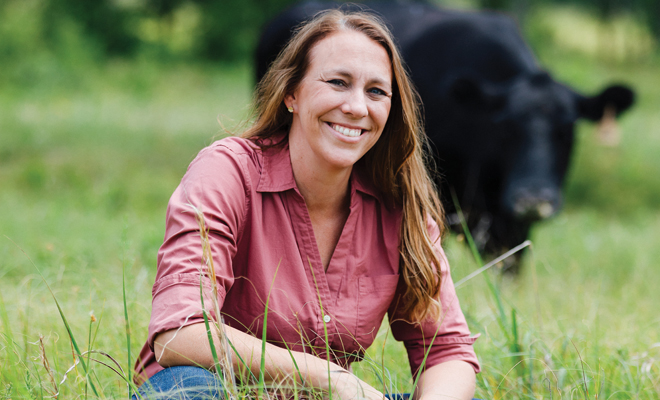 Amber J Deery
Amber J Deery
Sara Shivers: Cattle, Chickens and Children, Oh My!
A normal workday for Sara Shivers starts at about 5:30 a.m. with feeding the chickens and doesn’t stop until about 9:00 p.m. with either chasing cows or chasing kids, but she wouldn’t have it any other way. She’s doing what she loves and that’s running the Salt Creek Farm in Greenwood County, Kansas, along with her husband, Jay, and input from children Stella, six, and Margot, three. Tucked away in the Flint Hills along the beginnings of Salt Creek, this third-generation farm focuses on creating exceptional meats and handcrafted products from “Pasture to Plate,” with a special emphasis on their prized cattle.
“We’ve retained ownership from the time they were bred and taken to the butcher, which is about two to two-and-a-half years. They’ve always been with us, never in a feedlot. It’s pasture to the plate so you know exactly where it’s been its whole life,” Sara remarked. “You can ask me questions about how it was fed, what kind of feed we were using and more. Pasture to Plate allows you to know where your food is coming from and the people who grew it.”
Dedicated to Improvement
On Salt Creek Farm, the winds push across the open fields of thick, native grasses offering delicious grazing for Sara’s cattle. Black Angus make up the majority of the herd, although a few Red Angus are scattered throughout. The animals spend their entire lives in the pastures, with Sara and Jay focused on keeping the cattle happy and healthy as they draw upon agricultural knowledge stretching back generations. Salt Creek Farm is dedicated to creating a positive environment that supports cattle, chickens, pollinators and children.
Strutting, cackling and scratching their way across the fields at Salt Creek Farm are Sara’s high-quality chickens. “We have two different flocks that include the laying flock for laying eggs. For the meat birds, we were doing Bresse chickens, but we’ve transitioned to a New Hampshire breed. Our Bresse and New Hampshire are heritage breeds, which means they’ve been around a while.”
Her Bresse fowl boasts a French lineage with the claim of the best-tasting chicken in the world. While titles might be disputed, the beauty of this fowl cannot be disregarded: steel-blue legs, bright white feathers and large red combs. If European labels aren’t a necessity in your kitchen, you might consider the New Hampshire. After spending most of their time in the pastures, both breeds are butchered at 16 to 18 weeks. Sara shares that you’ll savor a better flavor from her stock than any grocery store poultry because they’re allowed to roam free and for three times longer than the confined-and-deprived standard commercial chicken. “The vast majority of the chicken grown today is a Cornish cross, which is bred to grow really big, really fast,” she commented. “They’re harvested at about six to eight weeks, and if they’re not harvested, they will die.”
In addition to these chickens, a mixed laying flock can be found rotating through the fields, laying rich brown eggs with yolks the color of a vivid orange sun sinking into the western horizon. The chickens are kept in the pastures and housed in mobile coops, pulled from field to field by four-wheelers. After they’ve worked over the fresh grass, the flocks are moved to another pasture, and the cattle follow behind them into the prairie they’ve just left and continue
the rotation.
Sara notes that she and Jay don’t grow lambs, but they’re partnering with a family friend who raises sheep and Salt Creek takes ownership at the butcher. However, next year the intention is to buy lambs when they’re weaned off their mamas and raised to yield. In the next three years, they want to run the entire operation.
When the Eyebrows Arch
Sara and her father, Don Stephens, run the Rafter S Ranch in Greenwood County, Kansas, featuring names for all of the pastures to ensure proper rotation and avoid overgrazing. He passed on his love of farming and livestock to Sara, who embraced her role and chores at a very young age. “My dad picked up while I was pretty young that I was the one sibling most interested in the farm. Tagging along, working cattle, even when I was little,” she said. “My dad had hogs in the ’80s when I was pretty young. One of my most vivid memories as a child was my dad waking me in the middle of the night and taking me down to the farrowing house, which is where we kept the hogs while they were having their babies. There he showed me a brand-new baby piglet and let me hold it.”
Along with the hogs, Don started raising cattle, focused on Black Angus, which soon became the farm’s primary livestock. While Salt Creek Farm built upon his knowledge foundation, Sara brought new ideas into the business to increase the farm’s output and profits. She introduced her family to the concept of social media and how it can drive connections to grow the business.
“My dad is my biggest supporter. When Jay, Stella and I moved back to Salt Creek Farm in 2014, he told me that if I have an idea, he would never tell me no. He said we’ll try it and if it works, great. If it doesn’t, that’s fine, but we’re going to try it. That type of mindset is huge, no matter who you’re working for,” she recalled. “He told me we needed to find a better way to market our beef, so I created my own market by selling beef directly to the people who wanted it. You can gauge his skepticism by how high his eyebrows go, but he went along with it to see what would happen. The first year we did not have a lot of success. Then my cousin opened City Barrel Brewing, and he wanted our beef on his menu. With that, we got our foot in the door and learned about working with restaurants.”
Pasture to Plate
According to Sara, the goal is to build Salt Creek Farm into a mid-level market, which means supplying restaurants on a regular level at the volume they need to have it on their menus full time. “Some that are doing the farm-to-table movement aren’t able to scale it up to do on a larger volume level,” she said. “That’s what we’re working towards, growing as much as we can, having the beef, adding the lamb, and having the chicken and, hopefully, adding pork in the next year or two.”
At this time, Salt Creek Farm is supplying about two dozen restaurants in Kansas City and that’s growing quickly. “I love talking with the chefs and asking for feedback, and I think they enjoy that connection, too,” Sara revealed. “Kansas City is such a great town because they’re embracing that kind of local food and supporting local agriculture.”
Yet, while wholesale production of beef supplies many restaurants in the Kansas City region, Sara notes that online sales are a significant part of her business equation. “We have a couple of options for customers to shop online. They can buy individual cuts that they want. We also have our subscription service, which we call our farm club. They can do that every month, every other month or every quarter. They can pick the frequency, and tell me their preferences. Each month I’ll send out an email saying, ‘I’m getting ready to put your box together; do you want anything special?’ We can customize it for each farm club member,” she explained. “They can have it shipped directly to their door. For Wichita customers, we have a pickup point and once a month they can pick it up. In Kansas City, we have a pickup point at Pantry Goods Market, and I’m up there every other week so they can pick up their box.” She added that customers are notified when seasonal products are available, such as lamb, whole chicken and honey.
Sara estimates that 95 percent of her business in 2019 went to restaurants. But then COVID-19 hit in 2020, which forced order cancellations due to mandatory shutdowns in March. Her online store was running, so the farm switched to focusing on retail, which took off in April. She recalls picking up a beef order from her meat processor and selling out in 13 minutes. In September, restaurants began to reopen, and now she has a nice balance of retail and restaurants.
Advice for Others
Given that she has experienced the ebb and flow of business and come back even stronger, Sara offers this advice to other entrepreneurs. “Be willing to pivot from your original goal. What you’re doing may not be working so let’s find what does work, just like we did with finding restaurants and then going back to individuals. Be flexible enough to find your target audience,” she stated. “I follow a lot of chefs and farmers on social media and see what other people are doing in their business. Maybe you can replicate their success.”
She values the benefit of finding the right person on the right day to guide others in achieving success. But that small business triumph cannot occur without a deep commitment from the community. “When you can shop local, do it because that money stays in the community. Local businesses spend money locally so it goes right back into your community. Shopping local is important. If you want those businesses to stay around, you have to support them,” Sara advised. “If you have questions about where your food comes from, find a farmer and ask him or her. If they can’t answer, I guarantee they will find someone who can. Farmers are happy when people ask us questions.”
Working a farm can be very fickle. The weather can be your greatest friend or worst enemy. Moving market prices may not cover investments or they can allow you to put money away in the kids’ education fund. But no matter the outcome, there’s something about having the freedom to enjoy an environment that generations before you have lovingly assembled.
“This is very much a family business. I would not be able to this without what my parents built–this amazing ranch–and I’m building on top of that,” Sara said. “Jay and I are keeping the same footprint, but we’re building up and not out as we grow the business.” ■









